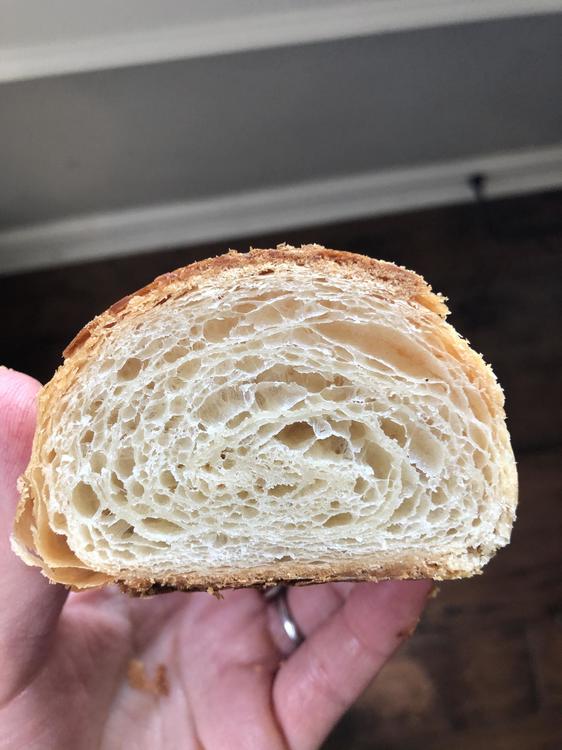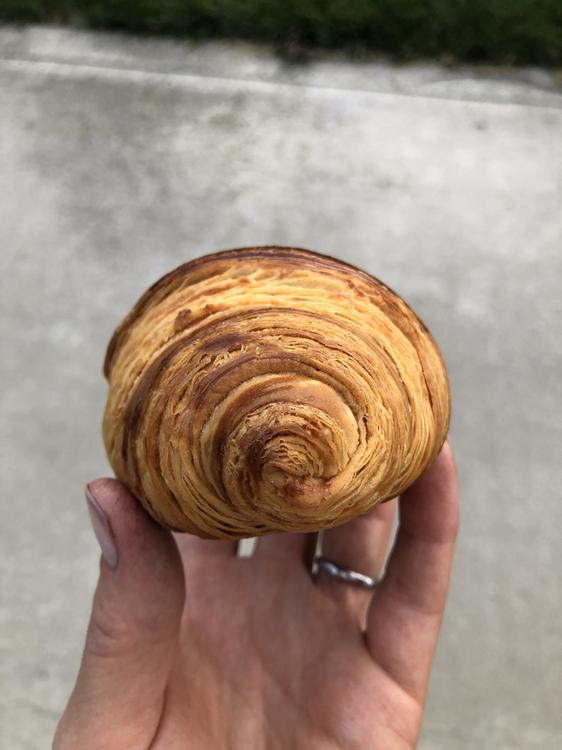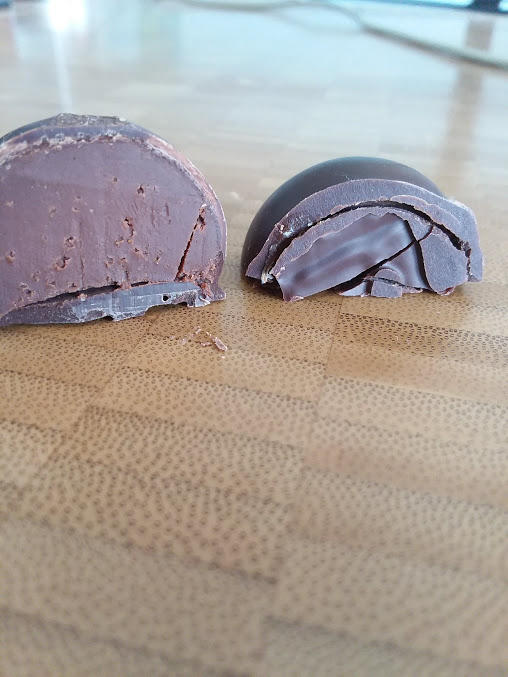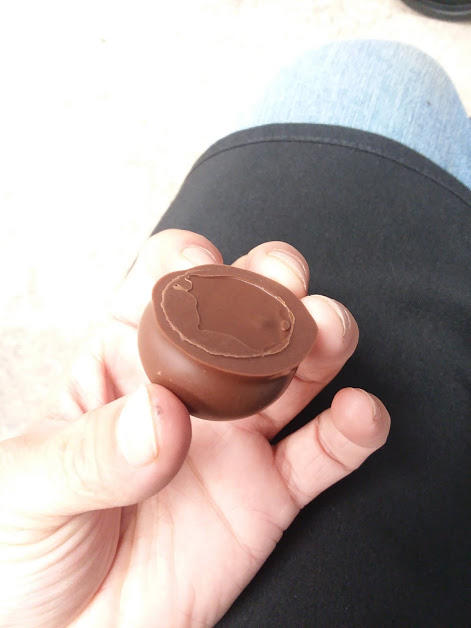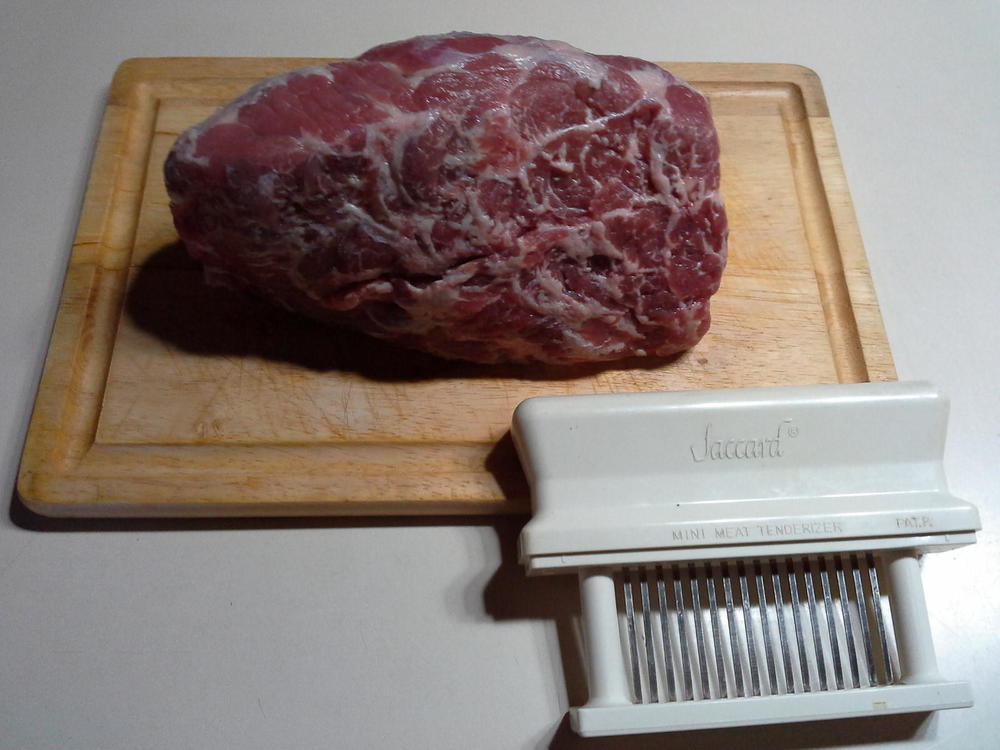Search the Community
Showing results for tags 'Troubleshooting'.
-
I'm trying to make a Roasted Poblano and Black Bean Enchilada recipe and I don't know if the tomatillo cream sauce will be freezer-friendly. Basically I process the following ingredients in a food processor to make the cream sauce. I plan on freezing the sauce in ice-cube trays for individual servings. The sauce will then be thawed and spread on a baking dish and also used to top the enchiladas and cook in a 400 degree oven. Thanks! INGREDIENTS: -26 ounces canned tomatillos, drained -1 onion -1/2 cup cilantro leaves -1/3 cup vegetable broth -1/4 cup heavy cream -1 tbsp vegetable oil -3 garlic cloves -1 tbsp lime juice -1 tsp sugar -1 tsp salt
- 4 replies
-
- Mexican
- Troubleshooting
-
(and 1 more)
Tagged with:
-
So I tried my hand at croissants for the first time in about 5 years. I used the recipe from the Bouchon Bakery cookbook. Despite the fact that I really struggled rolling them out (the dough was very stiff and resisted rolling), tore the dough layer in small patches quite a bit on the last turn, and probably took too long letting the butter get too warm, I got nice layers on the outside and on the interior and they did shatter nicely on the outside. I did not get that beautiful open honeycomb interior, however. I’d love any tips or feedback or advice anyone could offer to do better next time—thanks!
-
Hello, folks, thanks for reading. My husband thinks, I should start selling my popcorn seasonings (which I make for my family), it’s a good product. But I'm not sure if it’s interesting to other people... So, what do you think, guys? Our story: We’ve bought an air popper machine, but popcorn came out pretty tasteless. Then, we’ve bought different “popcorn seasoning” mixes... But it always ends with all the seasoning at the bottom of the bowl. Then, we've added butter, oil and so on before seasoning... we got soggy, chewy popcorn. Lot’s of disappointments… When we almost gave up… the magic happened! I figured out the way to make seasonings that: Stick to popcorn, but not sticky to fingers (or T-shirt , Easy to apply, May be pre cooked in bulk and stored… And popcorn appears crunchy, tasty, thoroughly covered with seasoning. Sounds good, yep? Now, when I want to treat myself - I only need 2 mins to turn tasteless popped popcorn to a real treat. The only moment - it request 1 extra effort: after you toss it over popcorn, you need to microwave it for 1 min, and stir after. So, I was wondering, if you like popcorn like myself - would this seasoning be interesting for you to purchase? Are you ready for a little extra work (microwave & stir) in the goal to flavor popcorn, or it feels too much effort? As I have no experience in manufacturing and retail, your answers would help me to make a very important decision - to dive in or not... Thanks in advance for your answers, it means the world to me.
- 14 replies
-
- Troubleshooting
- Confections
-
(and 2 more)
Tagged with:
-
I've recently started making caramels and been experimenting with lots of flavors and having a blast. One thing that I am having a hard time finding information about is the role of the different ingredients and how different ratios affect the firmness of a caramel. In particular, I have an espresso caramel recipe that I can't seem to get to the soft, no-effort-while-chewing texture that I've achieved with other flavors, yet I've stuck to the same temperatures as other recipes. This leads me to believe that the ratio of ingredients is key. I was hoping I'd be able to get some insight into how to alter ingredient ratios to produce a softer caramel. Any help would be appreciated.
-
I’m trying to find a recipe to make caramel suitable for varegating or swirling into Ice cream when the ice cream is loaded out of the ice cream maker to the ice cream storage container. When swirled at this stage it crams a nice caramel swirl when dipping. I have made several attempts, first attempt tasted great but got stringy and difficult to cut with a spoon. If you wanted to you could pull it out like a Spiders web. A typical caramel sauce will just disappear into the ice cream and seems to break down into the ice cream. Another attempt it got very sandy when cold and had to be hot to be dispensed into the ice cream, causing the base to melt away. Most useable commercial products seem to be heavy with corn syrup. I have tried that without success. Somehow I think that might be the key since the ingredient list for commercial caramel Variegate has it as the first ingredient and sweetened condensed milk the second item. Appreciate any recipes or formulas for a Variegating caramel creme ripple you might be able to offer or your suggestions. Thanks in advance!
-
I’ve been getting poor results with an old Betty Crocker recipie for Pecan Sticky Rolls. The glaze starts out smooth, but ends up crystallizing and I don’t know if it is the recipe, my technique, or something else. It specifies 1 cup brown sugar and 1/2 cup margarine (I substitute butter), melted to boiling, then add 1/4 cup dark corn syrup. That is poured in a pan with Pecans and the rolls are placed face down and the whole thing baked at 350 after a second rise.
-
I am trying to work on making some chocolates for my diabetic sister. As the sweetener, I used Swerve, an erythritol-based sweetener that supposedly behaves like sugar (and that my sister likes.) I added it to my standard milk chocolate recipe from Chocolate Alchemy- http://chocolatealchemy.com/recipes/dark-milk-chocolate-45 It came out of the melanger fine and set up OK. But, when I went to temper it, it would not melt! Even after an hour at 140F, it was about the consistency of peanut butter. Has anyone worked with Swerve and have any successful recipes? Or have any idea why it was so viscous? The stuff is darned expensive, so I don't want to experiment too much.
-
I have a nice recipe for Lamb shanks Rogan Josh. The recipe uses Greek style yogurt and stock along with the various spices and a long slow braise (3 hrs plus) 7 out of 10 times the result is that the sauce has the appearance of having split the yogurt from the stock. It does not seem to affect the flavor at all, its just the appearance. Is this the result of cooking at too high a temperature at some stage during the cook?
-
I dont believe that any English translation of Carêmes works exist. An incomplete version was published in 1842 (I think) but even the that version seems lackluster for the few recipes it does cover. I think it's time the world looks to its past, but I don't speak great French and it's a huge task to undertake. I hopefully plan on publishing this work and anyone who helps me will get a very fair cut, and if we decide not to publish it, I'll put it out on the internet for free. I'm working in Google docs so we can collaborate. I'm first cataloging the index to cross reference the pre-existing incomplete English version to give us a reference of what yet needs to be done, and from there we will go down the list of recipies and Translate them one by one. Simple google translate goes only so far, as it is 1700s French culinary terms and phrases being used. I'd like to preserve as much of Carêmes beautiful and flowery language as possible. Who's with me?
-
Posted 1 hour ago My truffles are cracking and leaking even when dipped at room temperature. I am so frustrated! Also some centres are too soft to dip unless chilled or frozen, suggestions? Also anyone have a good butterscotch truffle recipe with no icing sugar or cream cheese involved? thank you!
-
I have a slab of stone, I think it’s quartz, that I stored in my garage over the summer. The garage is kind of gross and buggy, there used to be a ton of old books in there so there were silverfish and the spiders who eat them. I don’t store paper goods out there but I figured stone would be safe. Yesterday I dusted off the bug poo and dragged the stone into the kitchen. Now I’m noticing tiny little perfections all over it, little spots where the stone has been etched into and catch when I run a fingernail across. I’m pretty sure they weren’t there in May. Is bug poo caustic enough to cause this? Or am I imagining things?
-
I have seen referenced in several places on the internet, including Wikipedia, a stat about escoffier recommending 40 minutes for scrambled eggs in a Bain Marie. I cant find where this number is from. On Wikipedia it refers to the book I currently own, the "Escoffier le guide culinaire" with forward by Heston Blumenthal by h. L. Cracknell...specificly page 157 for the 40 minute cooking time of scrambled eggs but it's not in my book on that page! Even tho there is the recipe for scrambled eggs on that page... I've seen the 1903 first edition online.. And it's not in there either.... Where is this number from?? Id like to know in case there is some even more complete book or something out there that I'm missing. Any help would be much appreciated. Thank you.
-
How to do it? I have a bag of non-gluten flour...probably just run-of-the-mill white...and a bag of gluten. Both go back a time or so. And really I have no use for either. The question is one of ratios. I know that one probably can't get it bang on and I won't be using it for baking cakes, but rather for making sauces or adding it here and there where 1/3 cup of flour is added to the mix and the gluten content is not paramount to the finished product. I Googled it seven different ways and found nothing useful. Some advice please.
-
Something I wonder about but have yet to attempt ... i usually make Swiss or Italian meringue buttercream with egg whites. Occasionally I make egg yolk buttercream if I have excess yolks. Is there any reason why one couldn’t make whole egg buttercream? Whole eggs whip up plenty fluffy for genoise, what if you added hot syrup and cool butter? 🤔
-
Hello everyone, I am in the process of locating a commercial kitchen space to rent in order to produce my chocolates on a larger scale, for retail and wholesale. The challenge is that I have not been able to locate a space that has air conditioning or any kind of temperature control. Even if everything else in the facility is perfect, that's the one issue that keeps coming up. Can anyone provide guidance regarding the feasibility of working in a non temperature controlled space, and if there are any work arounds? I'd have full access to fridges, freezers, etc... Thanks in advance for any help or experiences you can share! Miriam
- 18 replies
-
- Chocolate
- Confections
-
(and 1 more)
Tagged with:
-
So I've been experiencing cracks on the foot of my bonbons that I've been unable to find the cause of, hoping to reach out to the community to get to the bottom of this costly problem. I work for a small chocolate company that makes our own bean to bar couverture. We use a continuous tempering machine with enrobing belt attachment. The process: ganache is made and then piped into round silicone molds, which are then footed with tempered chocolate before being placed in the freezer until frozen enough to pop out of the molds. They are then set up right and left to thaw and dry out overnight on a equipped with fans aimed at the bonbons. The next day we send the bonbons through the enrober, and then they are transferred to a speed rack to set up, either at room temp (generally around 68-70 degrees F) or in a homemade cooling cabinet (an insulated box equipped with an air conditioner + dehumidifier + fans) that generally fluctuates between 50-56 degrees F (I know, large range). Problems occur with both milk and dark couverture, with bonbons kept at room temp or in cabinet, thickness of foot doesn't seem to make a difference (we've tried thicker and thinner). Crack doesn't immediately appear; it usually takes a couple of minutes after being completely set before showing. It looks as though the foot is popping out, cause a hairline crack between the shell and the foot. I've attached pictures. You'll notice in the photos, that when the bonbon is cut in half, the foot separates from the shell pretty significantly. Thoughts? Suggestions? Similar experiences?
- 3 replies
-
- Chocolate
- Confections
-
(and 1 more)
Tagged with:
-
I'm a small-scale hobbyist candymaker (making things for myself and friends, not for sale), and I'm interested in learning more about sugar panning (mostly soft sugar panning, but also interested in hard panning). I recently made myself a panning machine, and understand the very basics of the process, but I'm finding it difficult to find thorough information on the process that is useful for home candymaking - most of the information I have found so far has been of the sort "here is how to use this product that you can only buy in 100-lb quantities", or "this $200 industry manual has a section on panning techniques that may or may not be useful, but you can't tell until after you buy it". Is there a good book/website/other source that thoroughly explains all parts of the panning process with enough detail to figure out how to do things with the materials at hand, and more importantly how to know at each step if things are going right? I have access to the book "Confectionary Science and Technology", which has been a HUGE help, but there's still quite a bit that it doesn't talk about. I also have a couple of specific questions, and would appreciate any info: 1. How do I add color? Adding gel food color to the syrup only provides slight coloration, and I have food color powder but am not sure if I should add it to the syrup, to the sugar, or just it to replace the sugar. 2. I have some carnauba wax to use for polishing, but I can't find any info on how to use it - do I just pour a small quantity of melted wax to the centers in the pan? Do I need to mix it with anything? Huge thanks in advance for any information you can provide.
-
This probably sounds like a strange subject to bring up when most of you, as @CantCookStillTry would say, are up to your knickers in snow and ice but some of us right now are in a heat wave. Although Costa Rica is in the northern hemisphere, Central America only has two seasons. Wet and dry. Wet season is from sometime in April to sometime in November so that puts us in the dry season right now and our two hottest months are March and April. CCST is in Australia and going through a real hot time. We'd like to know what you do to beat the heat. What are your favorite hot weather recipes? How do you cook in the hot weather to keep from heating up your kitchen? Any and all suggestions and anecdotes are welcome.
-
I take great pride in that knowing the fact that I can replicate recipes on my own. I've had some pretty good success with coming up with flavors and foods that remind me of my youth, specifically, takeout items. I think I do a pretty good job of burgers, fried chicken, pizza, a multitude of a Chinese food dishes, etc. One item that I cannot seem to figure out, which should be so simple to do, but it's frustratingly and deceptively difficult, is Asian broth. I'm talking wonton soup and phö broth. I can't figure it out and I need help. I've scoured the forums here and tried everything. But I can't get a clear broth and I can't get the right flavour. I need to know what I'm doing wrong, I've spent a decade trying to figure this out. To me, there is nothing in this world like good soup broth. Can someone find it in them to help me, please? I would be forever grateful. Regards, Mike
-
At Groundhog's Day each year I start hunting for a good piece of meat to make corned beef for Saint Patrick's Day. I found the perfect piece yesterday and I have the perfect recipe (I found it 20 years ago on Food Network). I'm all set except that I have a small problem. My recipe calls for saltpeter and my supply is running low. I'm all set for now but saltpeter is impossible to find in Costa Rica. I usually have my grandson bring some when he comes but he almost always has a panic attack when he does it. I just can't imagine why he gets so nervous just bringing a little white bag of powder through customs. However, I can buy curing salt here. I've been on Google trying to find a pundit who can give me an amount substitution for curing salt and saltpeter. They all said that it can be done but no one seems to have a clear idea of how much to use and by how much I need to adjust the salt in the recipe. Because we have some real experts among our members I'm hoping someone can give me an idea about how to do this. Please, I need your help. Homemade Corned Beef I started my Saint Patrick's dinner yesterday. I used a homemade corned beef recipe that I have had a lot of success with. Corned beef is totally unheard of in Costa Rica so it is homemade or nothing. I love it so much that I make it at least two or three times a year. My biggest problem has been finding the meat that I need. The only type of cattle raised here are a big Brahma cross and they are all pasture-raised. The meat is lean and stringy and they always cut the brisket into small strips to be used for soup. To get a brisket you have to go to a slaughterhouse and buy the full brisket. Recently, I found a cut of meat that is not sold in the supermarkets or in the 'boutique butcher' shops. It is considered peasant food and it is wonderful. It is called giba (HEE-bah) and it is the hump of the Brahma bull. It's nice and marbled and very tender. They only sell it in the small local butcher shops and usually they have to order it for you. My two pound piece of meat ready to go. In the brine. Two weeks to go but it's going to be worth it. If anyone would like the recipe, I will post it on Recipe Gullet. Update: The recipe is here.
-
Hi, I'm David. I'm in the process of starting a new venture, and need some advice. I'm starting a catering company to cater to 4 golf courses, and hope to expand into other offsite catering after a year or so. I'm looking for a space to put a central kitchen to cook everything, and truck it out from there. We will be serving about 1200 people per weekend. Im having trouble visualizing how big of a kitchen space I'm going to need, and am having trouble finding anything online to help calculate the size of said space. Any help or advice would be greatly appreciated. Thanks in advance, Chef David
-
I used my homemade toffee in a cookie recipe hoping that the toffee will add a crunch to the cookie... it didn't turn out well as the toffee melted and didn't keep its hardened crunch form. How can I prevent my toffee from melting in my cookie recipe?
-
- Troubleshooting
- Cake
-
(and 2 more)
Tagged with:
-
Hello and Happy Holidays! I own an ice cream company and am looking for some information about equipment to use for scaling large batches of caramel. Right now, we cook sugar over electric heat in an approx. 6 qt. stainless steel pot. Once the caramel is at the correct color and temp (more on that below), we add our dairy to the hot mixture. Obviously, this is not a viable option for producing large batches. I'm familiar with confectionary equipment from Savage, but don't have the budget for an automated piece. Does anyone have experience with using just one of their copper or stainless steel kettles over a regular sized burner on electric heat? We've tried to use a single larger flat bottom pot sitting in the middle of all 4 burners on the stove to make a large batch of caramel, but it doesn't heat evenly. I'm wondering if the rounded bottom of the kettle helps the entire pot cook evenly -- would we be able to set the kettle right on the burner; or, have to use it in a double boiler setting? Additionally, any recommendations for thermometers that work well with caramel would be welcomed. We've used digital probes and candy thermometers, but on numerous occasions, the color and smell of the caramel that we associate with "doneness" is a dramatically different temperature for each batch. I came across a similar post on this topic from 2016, but aside from a recommendation for a large piece of equipment from Savage, there wasn't any other feedback. Hoping to get some good input that will bridge the gap between extremely small batches and mass production.
-
I like to make roasted eggplant/aubergine for baba gahanouj, bharta (etc.) on coals that impart a wonderful smoky flavour. I've had good success doing it in a barbecue (actually a Big Green Egg). So, now that it's winter, I thought "why not try it in the fireplace, after the fire has burnt down to glowing coals?" I cut a few slits in the eggplant so that it wouldn't explode, did NOT wrap it in foil, thinking that would just seal out the smoky flavour, and popped it into the fireplace (with glass doors) for 15 min. It came out looking good, perhaps a little under-cooked, but basically OK. The taste was TERRIBLE - very strong flavour of fire place ash. I only had a couple of bites, despite my Methodist ancestors looking disapprovingly over my shoulder, because it really was bad. So has anyone else tried this? I'd like to make it work. Should the eggplant be wrapped in foil? Should I wait until the coals have died down further? Does it depend on the type of wood? This was mainly aspen - crappy firewood at best, but it was free (Methodist ancestors won this time.).

